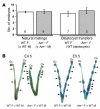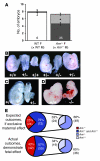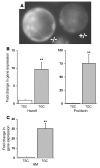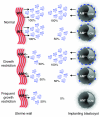Reduced maternal expression of adrenomedullin disrupts fertility, placentation, and fetal growth in mice
- PMID: 16981008
- PMCID: PMC1564429
- DOI: 10.1172/JCI28462
Reduced maternal expression of adrenomedullin disrupts fertility, placentation, and fetal growth in mice
Abstract
Adrenomedullin (AM) is a multifunctional peptide vasodilator that is essential for life. Plasma AM expression dramatically increases during pregnancy, and alterations in its levels are associated with complications of pregnancy including fetal growth restriction (FGR) and preeclampsia. Using AM+/- female mice with genetically reduced AM expression, we demonstrate that fetal growth and placental development are seriously compromised by this modest decrease in expression. AM+/- female mice had reduced fertility characterized by FGR. The incidence of FGR was also influenced by the genotype of the embryo, since AM-/- embryos were more often affected than either AM+/- or AM+/+ embryos. We demonstrate that fetal trophoblast cells and the maternal uterine wall have coordinated and localized increases in AM gene expression at the time of implantation. Placentas from growth-restricted embryos showed defects in trophoblast cell invasion, similar to defects that underlie human preeclampsia and placenta accreta. Our data provide a genetic in vivo model to implicate both maternal and, to a lesser extent, embryonic levels of AM in the processes of implantation, placentation, and subsequent fetal growth. This study provides the first genetic evidence to our knowledge to suggest that a modest reduction in human AM expression during pregnancy may have an unfavorable impact on reproduction.
Figures








Similar articles
-
Uterine activin receptor-like kinase 5 is crucial for blastocyst implantation and placental development.Proc Natl Acad Sci U S A. 2015 Sep 8;112(36):E5098-107. doi: 10.1073/pnas.1514498112. Epub 2015 Aug 24. Proc Natl Acad Sci U S A. 2015. PMID: 26305969 Free PMC article.
-
Adrenomedullin antagonist treatment during early gestation in rats causes fetoplacental growth restriction through apoptosis.Biol Reprod. 2004 Nov;71(5):1475-83. doi: 10.1095/biolreprod.104.032086. Epub 2004 Jun 30. Biol Reprod. 2004. PMID: 15229133
-
Defective trophoblast invasion underlies fetal growth restriction and preeclampsia-like symptoms in the stroke-prone spontaneously hypertensive rat.Mol Hum Reprod. 2017 Jul 1;23(7):509-519. doi: 10.1093/molehr/gax024. Mol Hum Reprod. 2017. PMID: 28402512
-
Fetal Growth Restriction: Does an Integrated Maternal Hemodynamic-Placental Model Fit Better?Reprod Sci. 2021 Sep;28(9):2422-2435. doi: 10.1007/s43032-020-00393-2. Epub 2020 Nov 19. Reprod Sci. 2021. PMID: 33211274 Free PMC article. Review.
-
Pathophysiology of placental-derived fetal growth restriction.Am J Obstet Gynecol. 2018 Feb;218(2S):S745-S761. doi: 10.1016/j.ajog.2017.11.577. Am J Obstet Gynecol. 2018. PMID: 29422210 Review.
Cited by
-
Fetal-derived adrenomedullin mediates the innate immune milieu of the placenta.J Clin Invest. 2013 Jun;123(6):2408-20. doi: 10.1172/JCI67039. Epub 2013 May 1. J Clin Invest. 2013. PMID: 23635772 Free PMC article.
-
Haploinsufficiency for adrenomedullin reduces pinopodes and diminishes uterine receptivity in mice.Biol Reprod. 2008 Dec;79(6):1169-75. doi: 10.1095/biolreprod.108.069336. Epub 2008 Aug 20. Biol Reprod. 2008. PMID: 18716289 Free PMC article.
-
Decoy receptor CXCR7 modulates adrenomedullin-mediated cardiac and lymphatic vascular development.Dev Cell. 2014 Sep 8;30(5):528-40. doi: 10.1016/j.devcel.2014.07.012. Dev Cell. 2014. PMID: 25203207 Free PMC article.
-
Uterine deletion of Gp130 or Stat3 shows implantation failure with increased estrogenic responses.Mol Endocrinol. 2013 Sep;27(9):1492-501. doi: 10.1210/me.2013-1086. Epub 2013 Jul 24. Mol Endocrinol. 2013. PMID: 23885093 Free PMC article.
-
HIF2α in the uterine stroma permits embryo invasion and luminal epithelium detachment.J Clin Invest. 2018 Jul 2;128(7):3186-3197. doi: 10.1172/JCI98931. Epub 2018 Jun 18. J Clin Invest. 2018. PMID: 29911998 Free PMC article.
References
-
- Baschat A.A. Pathophysiology of fetal growth restriction: implications for diagnosis and surveillance. Obstet. Gynecol. Surv. 2004;59:617–627. - PubMed
-
- Anthony R.V., Scheaffer A.N., Wright C.D., Regnault T.R. Ruminant models of prenatal growth restriction. Reprod. Suppl. 2003;61:183–194. - PubMed
-
- Scheffen I., et al. Alterations of the fetal capillary bed in the guinea pig placenta following long-term hypoxia. Adv. Exp. Med. Biol. 1990;277:779–790. - PubMed
-
- Ogata E.S., Swanson S.L., Collins J.W., Finley S.L. Intrauterine growth retardation: altered hepatic energy and redox states in the fetal rat. Pediatr. Res. 1990;27:56–63. - PubMed
-
- Schwartz J.E., Kovach A., Meyer J., McConnell C., Iwamoto H.S. Brief, intermittent hypoxia restricts fetal growth in Sprague-Dawley rats. Biol. Neonate. 1998;73:313–319. - PubMed
Publication types
MeSH terms
Substances
Grants and funding
LinkOut - more resources
Full Text Sources
Other Literature Sources
Medical
Molecular Biology Databases
Miscellaneous

